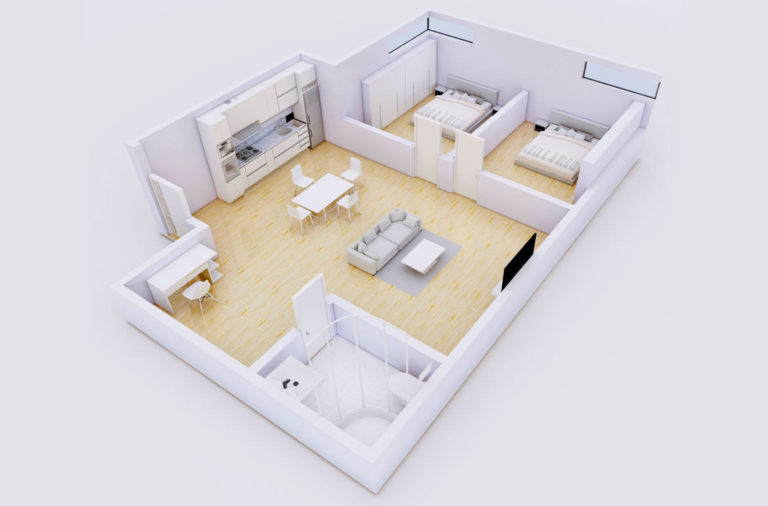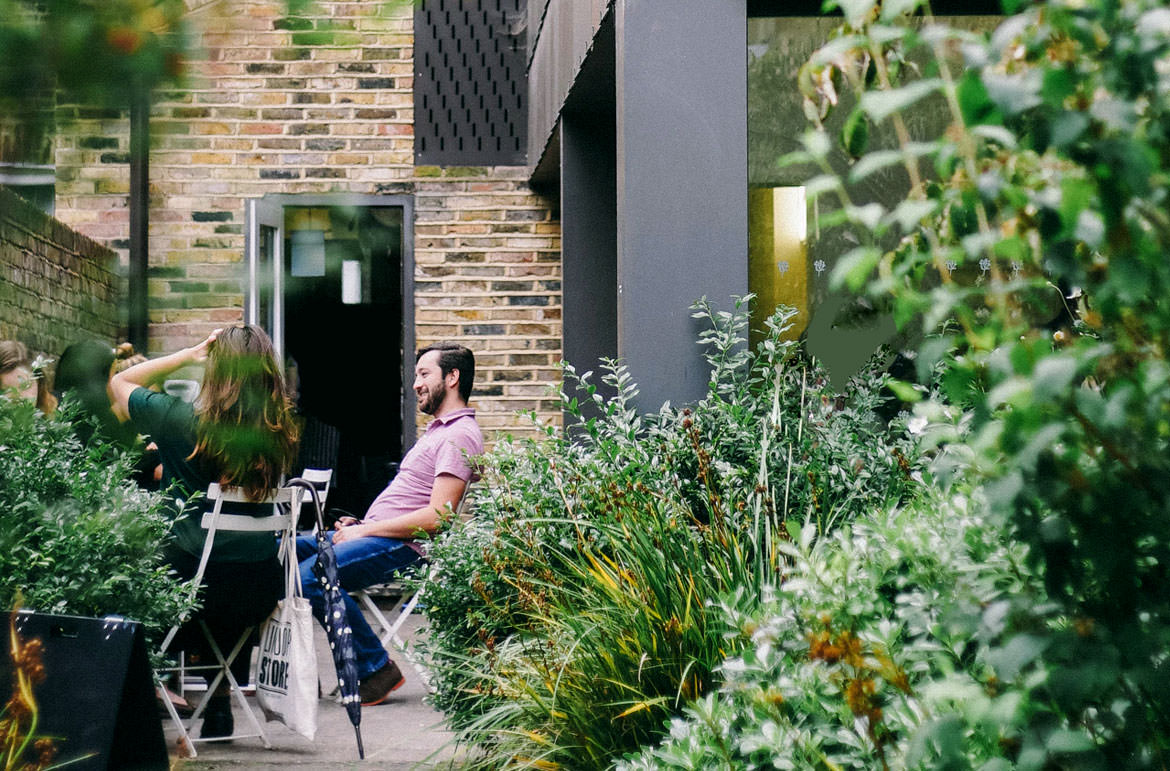
Not all blocks are perfect – but it doesn’t mean that they don’t have potential for a development. So, what needs to be considered before building a narrow granny flat?
- Site Orientation.
- Surroundings i.e. neighbouring buildings and overlooking issues.
- Placement of windows.
- Width of rooms, hallways and living space for furniture.
Today I will discuss how to best design a granny flat for a narrow block. I will also share inspiring ideas for a narrow design below.
Finally, I will talk about how to bring in light, creating the illusion of space.
DON'T PAY A FORTUNE FOR YOUR GRANNY FLAT. Find out how to deal with council and build a granny flat for the lowest cost possible. Learn More.
How to Best Design a Granny Flat for a Narrow Block
Narrow blocks can be quite complex but can also lead to some unique design opportunities.
To get the most out of your narrow block, it can really help to enlist the experience of a skilled architect when planning your design.
They will consider your:
- Site Orientation – It’s important to consider the orientation of your new dwelling. If your granny flat has its’ main living areas facing north, this will provide you with access to maximum natural sunlight during the day.
- Surroundings – With any property it is important to consider your surroundings. With a narrow block this is even more important. Surrounding buildings can affect what light your granny flat will get, so you will need to consider:
- The height of your neighbouring buildings.
- Setbacks.
- Areas overlooking your property.
So, an architect will consider the source of light at different times of the day (passive solar), to get a good idea of the areas of sun and of shadow.
- Privacy – Especially when building on a narrow bock, it is important to place your windows somewhere where you can:
- Maintain your own privacy, and
- Not create any overlooking issues with your neighbours. Whilst still letting in enough natural light. Solutions an architect will consider are glazed curtain walls or large windows in proper locations with window coverings if needed.
Basically, an architect will help you work with the complex land you have to create an ideal living space.
Other benefits and examples of architecturally designed granny flats can be seen here.
Best Design Ideas for a Narrow Granny Flat
When designing a narrow granny flat, it is important to consider the best design ideas for small spaces.
This includes:
Open Plan Designs – Combining rooms can allow for maximum space utilisation in a small area. What works well in a narrow space is to have an open plan kitchen, flowing through freely to the dining and living rooms. You can erase the need for any dividing walls, whilst still creating structure to the rooms, by simply defining the areas with furniture. Another great space-saving combination is keeping the laundry and bathroom in one room, which keeps all “wet” facilities in one space.
Spaces that Can be Used for Multi-Purposes – Another great way to save space is to have rooms that are flexible with their design. Meaning, they can easily be adapted to be used in various ways. Architectural designs will give you further knowledge on just how these multi-functional spaces can be used.
Higher Ceilings – What you are missing in width, can be made up for in height. Welcome vertical space with high ceilings. This will help even the smallest rooms feel spacious. 2.7m is a great number to reach, but do not be scared to aim even higher. Just keep in mind that a building taller than 3.8m means your setbacks will increase, which may not work for a narrow block. Instead, you can consider a void (an aesthetic feature that creates an area where light can enter the free space) above your kitchen, dining or living area.
A Cohesive Colour Palette – The belief that only white/light colours should be used in small spaces is incorrect. The trick is making sure you have continuity, or a flow, throughout the granny flat. Granny Flat Interiors will give you ideas on just what colours work well together.
Optimise Storage – From:
- Built-in robes in the bedrooms.
- Built-in shelves above the beds, and
- Kitchen cabinets that extend along the entire wall.
- Every possible storage solution needs to be considered.
I created a post on creating storage for your granny flat which will also give you other tips to maximise storage, such as:
- Using wall mounts, hooks, practical furniture, and
- Amalgamating all of your entertainment devices into one space.
Also, examples of some great completed narrow granny flat designs can be seen from this page at Granny Flats Australia.
Inspiration from Terrace Houses
Here are some great ways to make “Narrow Design” work best:
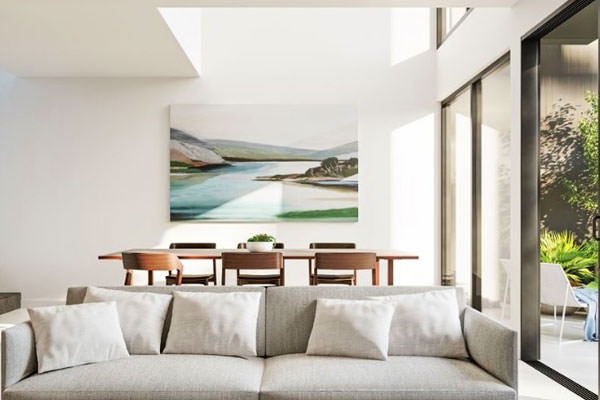
Source: Real Estate A great way to bring in light is to go vertical if you can.
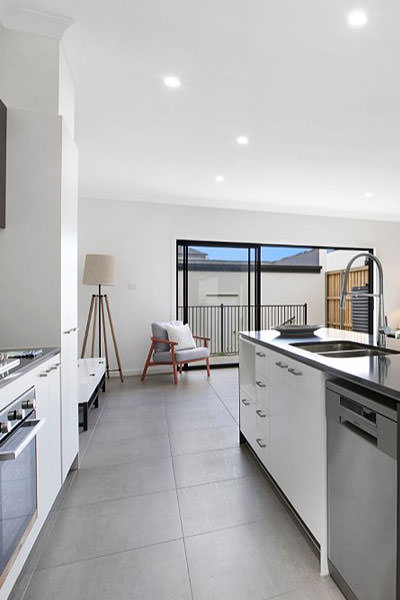
Source: Real Estate An island kitchen if you have room
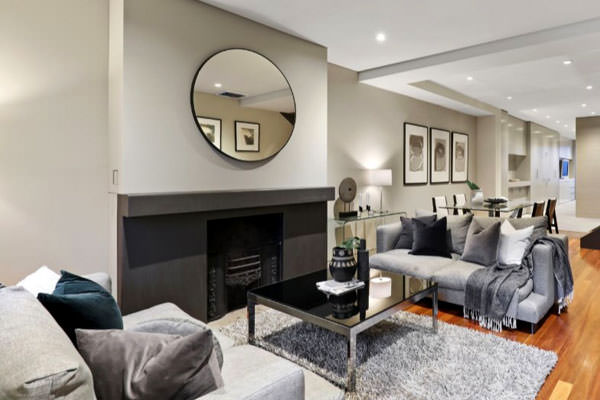
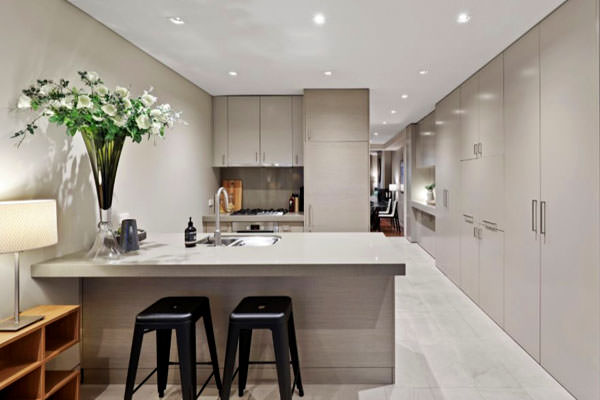
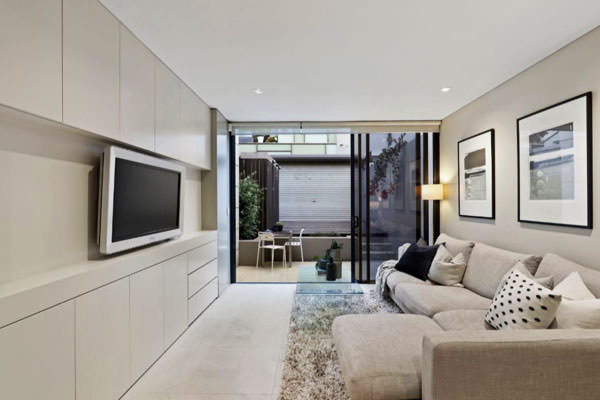
Source: Real Estate. Great layout including everything you need
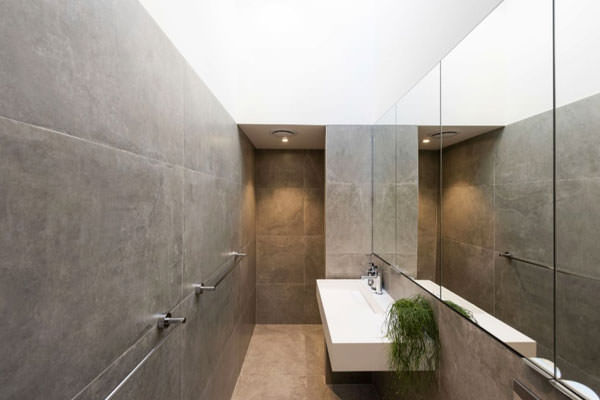
Source: Domain. Natural light in a small space works wonders
Consider the Thickness of the Walls
The building material you choose to use can actually reduce your internal floor space even more.
So, it is important to consider the thickness of the material you choose for the walls when designing your granny flat.
An example to keep in mind is that:
- A granny flat with brick veneer has a thicker external facade than,
- A granny flat made from timber and cladding (such as cement fibre for the outside walls).
The 2009 edition of the SEPP (State Environmental Planning Policy) stated that:
- The floor space of a granny flat is not measured internally, it must be measured from the outer walls.
As such, the thicker the building material you use for the walls, the more impact it will have on the amount of usable floor space that you are allowed.
So, as your floor space is measured from the outer wall of your granny flat, if you choose to build from double-brick, you could:
- Have up to 5 square metres less internal floor space, just because of the material you chose for the walls.
It is important to note that this is the typical floor area of a bathroom that you have given up – which is quite a lot in a narrow granny flat.
Hence why it is so important to put a lot of thought into the material you choose for walls.
Another thing to consider is to reduce any walls internally that you may not need. As internal walls take up floor space as as well. You may consider a one bedroom granny flat instead of two bedrooms. Then simply include a “study nook” in the corner of the living room, instead of an entire room. This saves an addition of at least 2 more walls.
Best Materials to Use for Narrow Designs
Another important thing to know about building materials is that what you see extends far beyond the surface.
Many materials are notably bigger in depth – As this is what provides the structure and insulation for the building.
On a narrow block you must make the most of the room you have, so it’s crucial to choose material that:
- Provides structural support whilst having the least affect on size.
Steel is generally more expensive than masonry walls (brick or building stone i.e. marble, granite, and limestone, cast stone, concrete block, etc.).
However, steel does allow for:
- A slightly thinner structure, and
- Larger openings for windows and doors.
On a narrow block, it would be worth spending the extra money on steel for the extra floor space and light it allows.
Another option is concrete – thin walls of panels can be pre-cast or poured on site. The advantages and disadvantages of choosing concrete can be seen here.
How to Bring in Light and Create the Illusion of Space
Drawing natural light into the house is highly important for many reasons.
Examples on just how light helps the granny flat can be seen in this post.
For example, skylights are great for narrow houses. Adding a narrow void down one side of the house can create some lovely shadow trails as well as be visually appealing.
As mentioned, glazed curtain walls are also a good idea on a narrow block. And if you have the space, something that looks fantastic is an internal courtyard with large double height windows. A feature such as this is both aesthetically pleasing and will flood your granny flat with light.
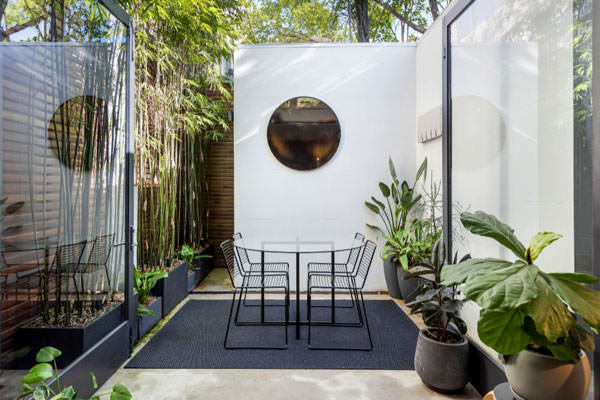
Source: Domain. A great courtyard which brings the outside, in.
The view you get from the windows is important – ideally you want to open your windows, connecting with the outside world, feel the breeze, see some greenery and hear the birds sing.
You don’t want to feel stuck inside, in a box, and unable to stretch your legs.
Conclusion
Narrow doesn’t necessarily have to mean small – don’t be narrow minded when it comes to a narrow block.
In fact, it’s not so much the size of the block that is the issue – it’s more how you design your secondary dwelling to fit comfortably within the available space you have.
The design phase is vital on a narrow block – there is less room for error.
But smart design techniques, including architectural knowledge, natural light, and clever choice of building materials can create excellent results.
So, have fun thinking outside of the box.
Pay particular attention to:
- Ceiling height: Can you build higher, adding more space?
- Impact on neighbours: There may be requirements regarding privacy, light, and views of neighbouring houses.
- Building materials – i.e. exposed steel can be an interesting design feature, and won’t reduce your internal floor space.
If you would like more help with your granny flat see how you can DIY and save money.




